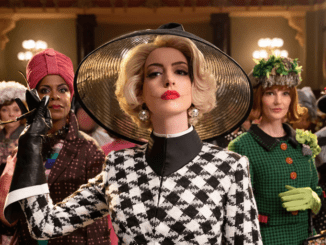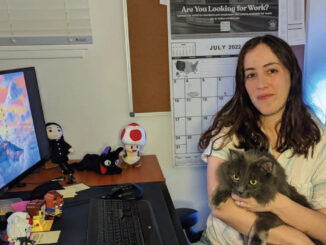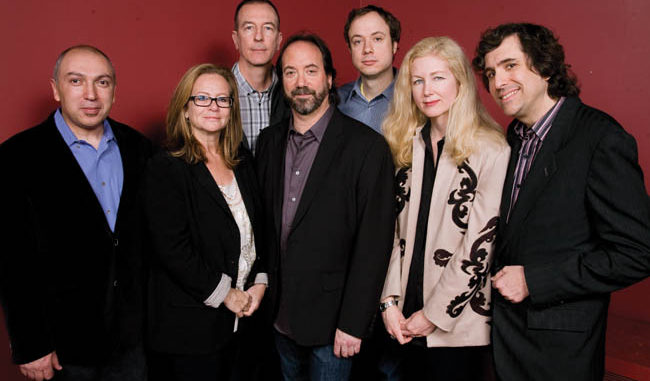
by Laura Almo • photos by Deverill Weekes
On Saturday morning, March 6, the eve of the Academy Awards, the American Cinema Editors (ACE) held its tenth annual Invisible Art/Visible Artists Seminar with the Oscar-nominated picture editors to a full house at the Egyptian Theatre in Hollywood.
Moderated by Alan Heim, A.C.E., the two-hour seminar was full of lively conversation about editing on location, bending the rules of editing, groundbreaking technology and story, story, story. The panel included Julian Clarke (District 9); John Refoua, A.C.E., and Stephen Rivkin, A.C.E. (Avatar; co-editor and director James Cameron was not available); Joe Klotz (Precious: Based on the Novel “Push” by Sapphire); Sally Menke, A.C.E. (Inglourious Basterds); and the ultimate winners, Chris Innis and Bob Murawski (The Hurt Locker).
Following are some of the exchanges.
Alan Heim: Julian, would you talk about the experience of editing District 9?
Julian Clarke: It’s hard to know where to begin. There’s a lot of different editing styles in District 9. We start out with a documentary, bearing-witness, anything-goes kind of style, then switch into a cinema verité drama style where it’s aesthetically similar and hand-held, but the camera is no longer addressed. At the end of the movie, it becomes action as well as documentary, and we’re throwing all the different styles at each other.
This actually made me really nervous. We set up one set of rules for the movie and then we switched to another because we couldn’t really justify the camera being with the main character once he transformed. I’ve only been called on it once so I guess we got away with it. Clearly for 99 percent of the audience, we got away with this rule-breaking and -bending and kind of switching the rules of the camera.
AH: You mentioned that you only got called once on the mistake that you were worried about. Certainly between the script and the execution of it there are any number of mistakes.
JC: Yeah, it’s differentiating between what’s the mistake––or oddity––that’s going to destroy the suspension of disbelief, and the one that will just kind of fly under the radar.
AH: We’re seeing a lot more movies with a hand-held documentary style that puts the viewer right in the middle of it.
Chris Innis: Director Kathryn Bigelow was really going for the docu feel to put you in the pain of what the soldiers were going through. With all the footage we got, which was about 200 hours, we had to cobble it together in a documentary fashion. We were also trying to be the Yin to the Yang, and to do it a little differently. We didn’t want to do jump cuts and all the different things that are traditionally used to cut documentary films. We wanted to treat it more formally, like a Hitchcock film. We wanted to focus on what the characters were doing.
Bob Murawski: The DP’s background was in documentary and Kathryn really wanted that style––to the point that a lot of times she wouldn’t even tell the actors where the cameras were, so they weren’t even aware of it. The cameras were all off on their own and a lot of times shots were being ruined by cameramen crossing in front of each other and crossing the line. We actually had to flop shots to make it smooth.
AH: That was a stunning clip from Precious. Where did the idea come from of breaking up the violence with stills of lovely moments?
Joe Klotz: I chose the clip because I wanted to talk about the relationship between the director and an editor being based on trust and wanting creativity from each other to make the best film possible.
I had cut the scene a million different ways; I had very limited footage, and not the greatest stunt work. I thought I’d finally gotten it close to where it would work and director Lee Daniels said, “That’s really good, but I think I want to shoot some stills.” I said to myself, “Oh my God, that’s the last thing this scene needs,” because it was slow and not working. Of course, I didn’t say that to him because of that trust. I let him explain his idea and we talked it out. It was Lee’s idea to treat the photos as a progression. When she’s younger, she’s happy, and as she gets to the age when she’s abused, you see her as more sullen and distant, obviously not happy.
But the point about the give and take is that Lee flew out to shoot those stills and then I tried cutting them in. He didn’t say, “Cut them in this way,” and so I tried a million different ways and was able to refine the fight. I had trust in him and he had trust in me to make something of it. I think that’s the fun of having a great collaboration with someone.
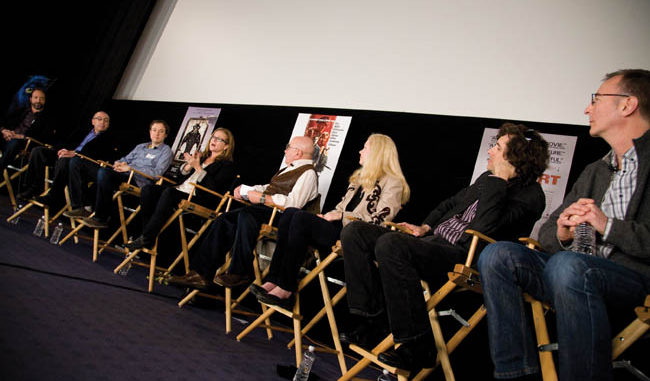
AH: So you look at the dailies. And then what do you do?
JK: This might be an anathema to most editors, but I don’t really screen the dailies straight through. As I look at the dailies, I want to start cutting; if I see something I like, I don’t have a pre-conceived notion of what I’m going to do with it. I just start building things that I like and if I find something better, I’ll put that in and take the other thing out because I really want to rely on my gut and my intuition on what works. I find in a performance like this that you really need to go with your gut––what your first impression is. That gets borne out when you’re showing the director the scene for the first time…whether your gut was right.
BM: I normally feel really strongly about screening everything and especially on the big screen. I would take some notes but, for me, it’s more about getting an overall impression of all the footage and remembering a bigger screen experience––and then going back to the editing room and putting the stuff together.
Chris actually started The Hurt Locker and I came on after they had wrapped production. There was so much footage that there literally weren’t enough hours in the day for me to screen everything and start working on it so I was actually kind of doing it the way Joe Klotz was talking about doing it. I would still build everything together into a giant camera roll like in the old days. Even though it was on a digital system, it kind of forced me to always keep going through the footage. It was actually a good way for me to keep familiarizing myself with the material and making sure I didn’t miss anything.
AH: Because of the technology, you didn’t really have dailies on Avatar.
Stephen Rivkin: Let me just start out by saying that I have everything before Avatar, and then Avatar––because there was nothing normal about how we did this film, how dailies occurred or anything. The film was shot a couple of times. At first all the actors’ performances were captured, including their facial expression and dialogue. We had to pick the best performance, and sometimes combine performances from different takes. We had this whole pre-cut process before layer upon layer of different elements were created to process and play back with no actors.
John Refoua: There was a point when we screened the movie and more than 70 percent of it was basically just actors in motion-capture suits. But once we picked the performances, Jim Cameron would say, “Okay, this is the performance.” Once in a while he would change it, but then he could focus on the shot creation; that was a really interesting experience for us. It’s something that editors don’t normally get involved in, but we were on the stage as Jim was picking his shots. The nice thing was that we knew all the performances. We were very intimately aware of every little twitch, every little eye blink and every little look. We had these things pretty much memorized, and it helped quite a bit.
AH: Do you feel that performance capture is a direction that filmmaking will go in a big way? It’s incredibly expensive.
SR: There are applications from the performance-capture phase for smaller productions, where a scene that requires an actor to gain 400 pounds or age 50 years will be possible without the actor having to sit in a make-up chair for four hours everyday or wear a fat suit.
AH: Sally, can you introduce the clip from Inglourious Basterds?
Sally Menke: This is where Goebbels [Sylvester Groth] is trying to convince Shosanna [Mélanie Laurent] that the premiere should be at her theatre, and then Landa [Christoph Waltz] comes in and she realizes that he is the person who killed her family. The first thing I wanted to say is that it was kind of eerie to go on location where Goebbels and Hitler used to have lunch. Goebbels’ office next door is still standing, and when you went on location, you saw people in uniform and the French dressed up. Quite frankly, it was very scary to be there.
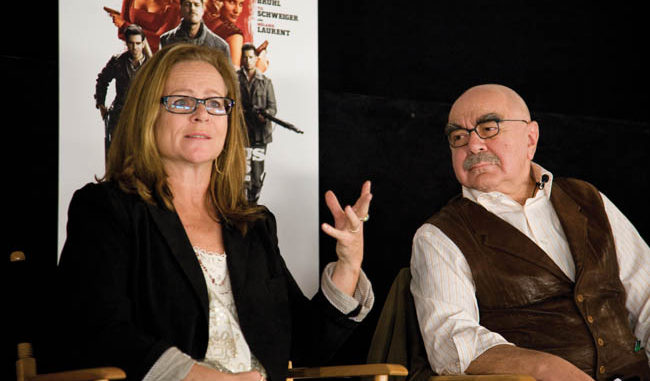
AH: Could you talk about the interplay of restraint and humor?
SM: One of the most important things that director Quentin Tarantino does so beautifully and brilliantly is the interaction of tension and humor; you laugh and you find yourself knowing that it’s not appropriate because, in fact, it’s very tense. That is one of the things that we worked so hard at and really tried to make it work appropriately and inappropriately.
At the end of the scene, Shosanna goes into a huge well of tears and we cut it short. We only wanted her to just release the breath; she had to remain a fountain of strength because she was going to plan the death of Hitler. So we cut it at that moment––that specific frame––because she had to have the release, but she had to remain strong. We had to leave her not as a wimpy girl but as a woman of strength.
AH: I know you had something like 40 minutes to remove from the final version of Avatar. How did you decide what to take out?
SR: Technology aside, I think all of us have to deal with projects that become way overblown and have to be compressed. You know there are several phases to editing, and we had a preliminary phase that doesn’t exist normally, but we did go through the normal process of putting individual scenes together and then problem solving to fix things that didn’t work. I think some of the biggest challenges we all face are downstream in the process when very tough decisions have to be made about scenes removed or shortened, and about finding the essence of what needs to be told to keep the story going.
JR: There’s a really nice scene where Sam Worthington talks to Grace, the Sigourney Weaver character, about what he’s feeling, how he’s in love with this girl and how he has to follow the directions of the bad colonial. It’s a really beautiful scene––but we ended up taking it out because it didn’t keep the plot moving along. Sometimes you don’t need to have a scene that tells you what the thought process is if the audience is actually thinking it themselves.
AH: There’s been a lot of stuff in the papers and in the trades in the last couple of weeks attacking the veracity of The Hurt Locker. This doesn’t affect us as editors and storytellers, but do you have any comment on it?
CI: We had military advisors on the film and it was really important to Kathryn to have the authenticity of the feeling that you’re there. It doesn’t have to be 100 percent perfect. The main thing we’re doing is making a fictional film; we’re not making a documentary or a training manual for the army. It’s a film about characters going through a really difficult, challenging war, and our goal was to bring the brutality and reality of war to the audience, and not necessarily to have every single little tiny thing perfect. Because you can’t; you would never be able to do it.
Laura Almo is a freelance writer and documentary filmmaker, as well as an editing teacher. She can be reached at lauraalmo@mac.com.



